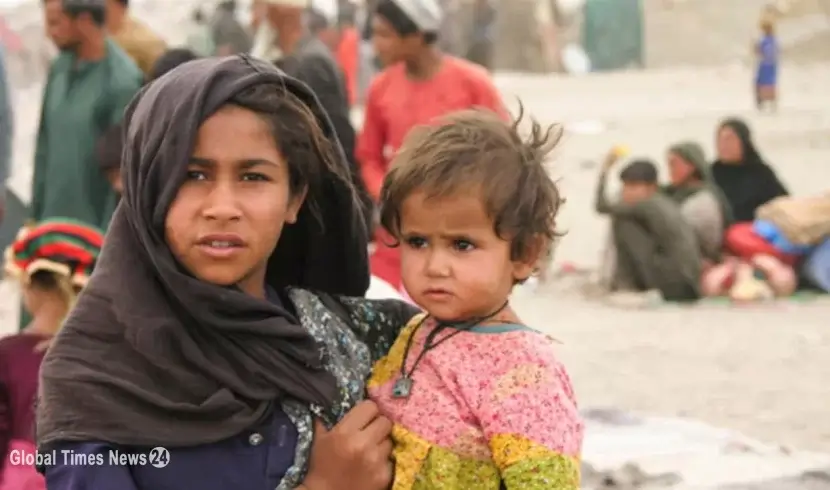Hosting countries
The report highlighted that Türkiye is the world’s top host of refugees with nearly 3.6 million refugees.
It is followed by Iran with 3.4 million, Colombia with 2.5 million and Germany with 2.1 million.
Relative to their national populations, Lebanon and Aruba hosted the most refugees and other people in need of international protection as one in seven and one in six are displaced, respectively.
Meanwhile children, which make up 30% of the world’s population, accounted for 40% of all forcibly displaced people, according to the report.
On new claims, the report said the US was the world’s biggest recipient of new individual applicants, as it received 730,400 claims of a total 2.6 million in 2022.
Germany followed the US with 217,800. Costa Rica, Spain and Mexico completed the top five recipients.
The report emphasized that 52% of all refugees and other people in need of international protection came from just three countries: Syria (6.5 million), Ukraine (5.7 million) and Afghanistan (5.7 million).
Also, the total number of refugees worldwide increased by a record 35%, or 8.9 million people, to 34.6 million at the end of 2022, it said.
The increase was largely due to refugees from Ukraine fleeing the armed conflict in their country and revised estimates of Afghans in Iran and Pakistan, it added.
“These figures show us that some people are far too eager to resort to conflict and way too slow to find solutions,” said Filippo Grandi, the UN High Commissioner for Refugees. “The consequence is devastation, displacement, and anguish for each of the millions of people forcibly uprooted from their homes.”
Returns and resettlements
The report also recorded some positive progress as six million displaced people returned to their areas of countries of origin in 2022, including 5.7 million internally displaced people (IDPs) and 339,300 refugees.
Meanwhile, 114,300 refugees were resettled, doubling the figure of the previous year (57,500), according to government statistics.
Also, the UNHCR submitted 116,500 refugees to states for resettlement, according to the report.
“While the number of refugees and IDPs who found a solution increased in 2022 compared to the previous year, durable solutions continue to remain a reality for very few people,” the report noted.
During 2022, at least 5.7 million IDPs returned to their place of origin, 8% more compared to the previous year, it said.
And for refugees, solutions such as voluntary repatriation, local integration and resettlement to a third country and family reunification prompted 339,300 refugees to return to their countries of origin, while 114,300 refugees were resettled to a safe third country.
For each refugee that returned or was resettled in 2022, there were 16 new refugees, the report added.
 UN Envoy: No Justification for Subjecting Palestinians to Collective Punishment
Human Rights / Breaking News
UN Envoy: No Justification for Subjecting Palestinians to Collective Punishment
Human Rights / Breaking News
 Looking for Ways to Restart Aid in Northern Gaza: WFP Leader
Human Rights / Breaking News
Looking for Ways to Restart Aid in Northern Gaza: WFP Leader
Human Rights / Breaking News
 WFP Suggests Flexible and Stable Funding to Address Humanitarian Aid Funding Gap
Breaking News / Human Rights
WFP Suggests Flexible and Stable Funding to Address Humanitarian Aid Funding Gap
Breaking News / Human Rights
 Un Chief warns world faces real risk of multiple famines in 2022
Human Rights
Un Chief warns world faces real risk of multiple famines in 2022
Human Rights
 Pope Francis calls for an to end human rights violations during his visit to Bahrain
Human Rights / Breaking News
Pope Francis calls for an to end human rights violations during his visit to Bahrain
Human Rights / Breaking News
 Nakba 75: Palestinian citizens of Israel are exiles in their own land
World / Opinion
Nakba 75: Palestinian citizens of Israel are exiles in their own land
World / Opinion
 Rwanda’s decision to take in migrants not surprising: Analysts
Human Rights
Rwanda’s decision to take in migrants not surprising: Analysts
Human Rights
 Major sports events of 2022
Sport / Breaking News
Major sports events of 2022
Sport / Breaking News
 Internally displaced worldwide reached record 59.1M in 2021: Monitor
Human Rights
Internally displaced worldwide reached record 59.1M in 2021: Monitor
Human Rights
 Djokovic row highlights plight of asylum seekers in Australia
Human Rights
Djokovic row highlights plight of asylum seekers in Australia
Human Rights